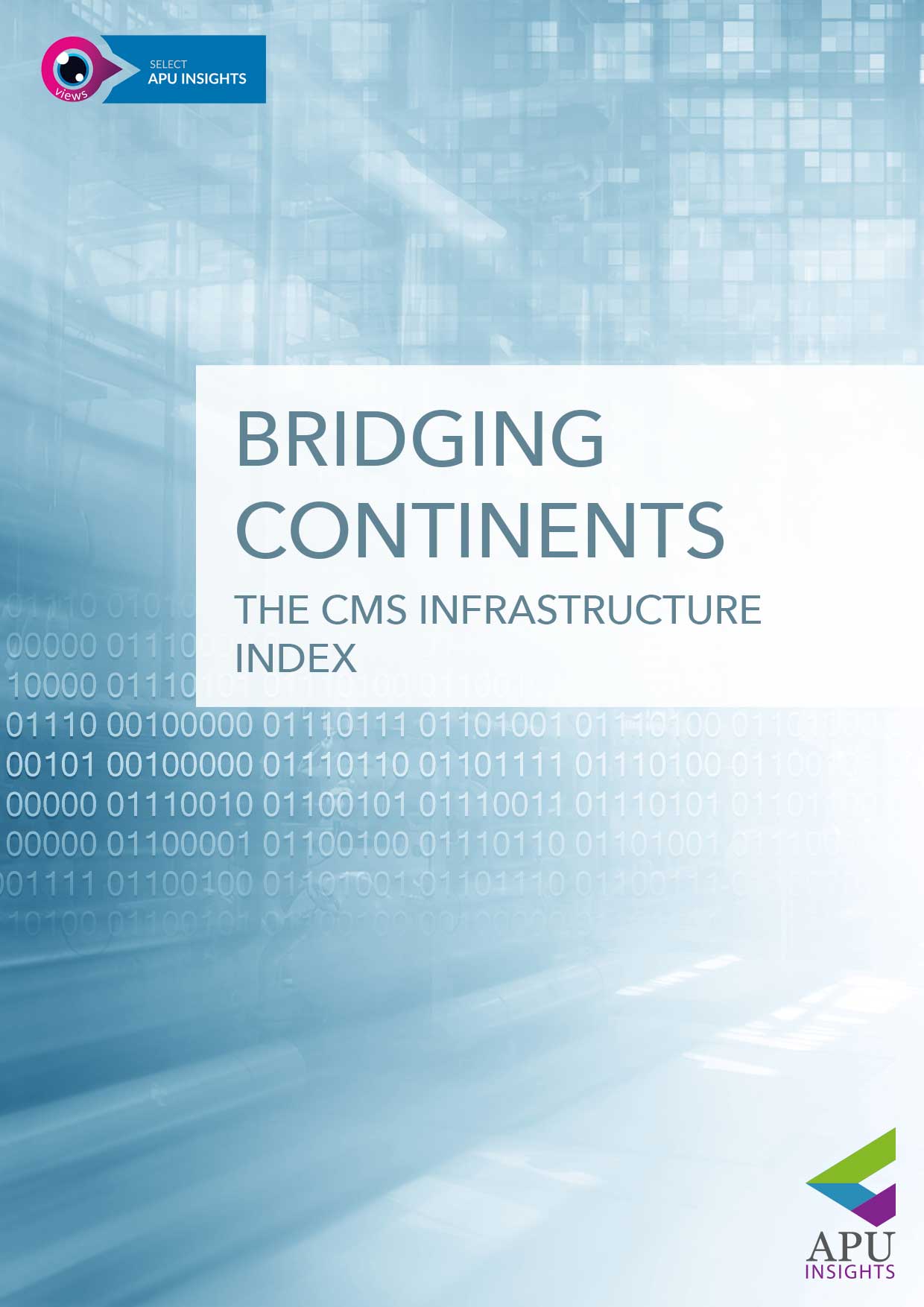Bridging Continents | The CMS Infrastructure Index
Dr. Evangelo Damigos; PhD | Head of Digital Futures Research Desk
- Connected Intelligence
- Sustainable Growth and Tech Trends
Publication | Update: Oct 2020

Governments globally are investing heavily in infrastructure assets to stimulate their economies.
The CMS Infrastructure Index analyses data across 50 jurisdictions against six criteria to create a guide to the most attractive destinations for infrastructure investment.
In Bridging Continents, the 2019 CMS Infrastructure Index, we see that infrastructure is connecting people worldwide at an unprecedented pace. Developing economies are investing heavily in roads, rail and airports to drive economic growth and bring them closer to international trading partners and the rollout of 5G and building of smart cities are creating new digital highways.
Overall, Europe claimed six of the top 10 countries in this year’s Index.
Germany has taken top spot. Germany’s focus on sustainability and innovation is the driving force behind its position. The country is aiming to make climate action part of the German national identity and supporting this through a number of offshore wind projects, construction of a fourth electricity highway and an extensive EV charging program.
Germany overtook the Netherlands to take the top spot in the 2019 Index, thanks to its considerable sustainability and innovation drive. The country is putting climate action at the center of the German national identity, supported by a number of offshore wind projects, the construction of a fourth electricity highway and an extensive EV charging program. Elsewhere, notably the Brexit-effect is taking its toll on the UK infrastructure sector as it slips five places to 9th position on the 2019 Index.
The UK’s story is not so positive. We see the UK fall from fourth in 2017 to ninth in 2019. The Brexit-effect. There is a steady pipeline in some infrastructure sectors, for example rolling stock renewals in England and transport in Scotland. There is also a shift from primary to secondary investments. However, unsurprisingly the political uncertainty has led to delays on flagship projects (e.g. HS2 and Heathrow airport) and a decrease in lending to UK projects.
Another country to note is China, which has risen by 10 points since the 2017 index and is now in 18th position. 5G is instrumental in China’s increased ranking, due in part to major corporations such as Huawei and ZTE ; over 10 million advance orders for 5G data plans were submitted to China’s three mobile operators, and they will deploy a total of 130,000 standalone 5G base stations across the country by the end of 2019.
Other findings in the report show:
- Asia Pacific: leaders in digital transformation: Investment in digital infrastructure is on a general upswing in the Asia Pacific region, with major hubs vying for supremacy in the communications sector. Singapore ranks 3rd in the overall Index, with numerous digital infrastructure investment opportunities are backed-up by strong regulatory frameworks and initiatives such as Singapore’s Digital Industry (DISG), an authority dedicated to driving digital infrastructure investments, further bolstering the country’s reputation as Asia’s data centre hot spot. China has also shown significant improvement in the rankings, rising by 10 points since the 2017 index to claim 18th spot, thanks to its considerable 5G efforts. Over 10 million advance orders for 5G data plans were submitted to China’s three mobile operators, and they will deploy a total of 130,000 standalone 5G base stations across the country by the end of 2019.
- Smart cities shaping the Middle East’s future: As private-led investment continues to build across the region, the report shows that the Middle East is making significant headway in becoming a global smart and sustainable city hub. Supportive PPP legislation in the UAE, Kuwait, Qatar, Oman and soon Saudi Arabia is set to increase investor confidence and support for the region’s economic diversification. The region has also presented some of the most ambitious solar and onshore wind projects including closing a pipeline of over 2.8GW, according to Inspiratia, and putting renewable energy at the center of its growth agenda.
LatAm leads innovation across the Americas: Major interconnectivity projects in Latin America mean that the region is leading on innovative digital infrastructure of the future. Latin America has some mega interconnectivity projects, presenting some exciting developments. Examples include a 3,500km-long submarine fiber optic network from the north to the south of Chile and the recently completed 10,000km subsea cable connecting California to Chile. On the other side of the continent, Brazil is working on the innovative 9,300km EllaLink subsea cable system bridging between the American (Brazil) and European continents (Portugal and Spain).
In North America, Canada has maintained its appeal to private and institutional investors through strong PPP procurement activity. Despite high-profile announcements in the US to improve the country’s highways, railways, bridges and broadband, discussions with the government on these issues have come to a halt.
- African trade ambitions boost interconnectivity: Fiscal constraints and limited project finance capabilities may hinder ambitions, but African governments are starting to open their doors to greater private investment to overcome their infrastructure shortfall. East Africa in particular demonstrates strong political will for renewables. Kenyan President Uhura Kenyatta has announced an ambitious program to move Kenya’s installed renewable energy capacity from 70% to 100% by 2020. A target well within reach due to the 310MW Lake Turkana wind farm, which was connected to the national grid, via the new USD 271m Loiyangalani-Suswa power transmission line, in December 2018.
Kristy Duane, Co-Head of Infrastructure and Project Finance at CMS, comments: “Infrastructure is connecting people worldwide at an unrelenting level. With sustainability, innovation and digital transformation at the heart of government agendas, investors are finding new and exciting opportunities on a global scale, including in 5G, subsidy-free renewables, smart cities and PPP in new markets.
As the world focuses on climate change and sustainability, we see this transferring to the infrastructure sector too.
Infrastructure assets have a vital role in climate change mitigation and economic, social and governance (ESG) criteria are an increasingly popular way for investors to evaluate companies in which they might want to invest. However, the sector is facing a number of challenges, including lack of governance, an absence of objective standards and as a result, no regulations on how to report and measure performance. Regulators globally are working to create their own regulations in this area but with each country creating its own standards, international operators will face a complex matrix of requirements for different projects around the world.
 Digital Themes: Connected Intelligence, Sustainable Growth and Tech Trends
Digital Themes: Connected Intelligence, Sustainable Growth and Tech Trends

HTML
 Access Rights | Content Availability:
Access Rights | Content Availability: 


Objectives and Study Scope
This study has assimilated knowledge and insight from business and subject-matter experts, and from a broad spectrum of market initiatives. Building on this research, the objectives of this market research report is to provide actionable intelligence on opportunities alongside the market size of various segments, as well as fact-based information on key factors influencing the market- growth drivers, industry-specific challenges and other critical issues in terms of detailed analysis and impact.
The report in its entirety provides a comprehensive overview of the current global condition, as well as notable opportunities and challenges.
The analysis reflects market size, latest trends, growth drivers, threats, opportunities, as well as key market segments. The study addresses market dynamics in several geographic segments along with market analysis for the current market environment and future scenario over the forecast period.
The report also segments the market into various categories based on the product, end user, application, type, and region.
The report also studies various growth drivers and restraints impacting the market, plus a comprehensive market and vendor landscape in addition to a SWOT analysis of the key players.
This analysis also examines the competitive landscape within each market. Market factors are assessed by examining barriers to entry and market opportunities. Strategies adopted by key players including recent developments, new product launches, merger and acquisitions, and other insightful updates are provided.
Research Process & Methodology

We leverage extensive primary research, our contact database, knowledge of companies and industry relationships, patent and academic journal searches, and Institutes and University associate links to frame a strong visibility in the markets and technologies we cover.
We draw on available data sources and methods to profile developments. We use computerised data mining methods and analytical techniques, including cluster and regression modelling, to identify patterns from publicly available online information on enterprise web sites.
Historical, qualitative and quantitative information is obtained principally from confidential and proprietary sources, professional network, annual reports, investor relationship presentations, and expert interviews, about key factors, such as recent trends in industry performance and identify factors underlying those trends - drivers, restraints, opportunities, and challenges influencing the growth of the market, for both, the supply and demand sides.
In addition to our own desk research, various secondary sources, such as Hoovers, Dun & Bradstreet, Bloomberg BusinessWeek, Statista, are referred to identify key players in the industry, supply chain and market size, percentage shares, splits, and breakdowns into segments and subsegments with respect to individual growth trends, prospects, and contribution to the total market.
Research Portfolio Sources:
Global Business Reviews, Research Papers, Commentary & Strategy Reports
M&A and Risk Management | Regulation

The future outlook “forecast” is based on a set of statistical methods such as regression analysis, industry specific drivers as well as analyst evaluations, as well as analysis of the trends that influence economic outcomes and business decision making.
The Global Economic Model is covering the political environment, the macroeconomic environment, market opportunities, policy towards free enterprise and competition, policy towards foreign investment, foreign trade and exchange controls, taxes,
financing, the labour market and infrastructure.
We aim update our market forecast to include the latest market developments and trends.
Review of independent forecasts for the main macroeconomic variables by the following organizations provide a holistic overview of the range of alternative opinions:
As a result, the reported forecasts derive from different forecasters and may not represent the view of any one forecaster over the whole of the forecast period. These projections provide an indication of what is, in our view most likely to happen, not what it will definitely happen.
Short- and medium-term forecasts are based on a “demand-side” forecasting framework, under the assumption that supply adjusts to meet demand either directly through changes in output or through the depletion of inventories.
Long-term projections rely on a supply-side framework, in which output is determined by the availability of labour and capital equipment and the growth in productivity.
Long-term growth prospects, are impacted by factors including the workforce capabilities, the openness of the economy to trade, the legal framework, fiscal policy, the degree of government regulation.
Direct contribution to GDP
The method for calculating the direct contribution of an industry to GDP, is to measure its ‘gross value added’ (GVA); that is, to calculate the difference between the industry’s total pretax revenue and its total boughtin costs (costs excluding wages and salaries).
Forecasts of GDP growth: GDP = CN+IN+GS+NEX
GDP growth estimates take into account:

Market Quantification
All relevant markets are quantified utilizing revenue figures for the forecast period. The Compound Annual Growth Rate (CAGR) within each segment is used to measure growth and to extrapolate data when figures are not publicly available.
Revenues
Our market segments reflect major categories and subcategories of the global market, followed by an analysis of statistical data covering national spending and international trade relations and patterns. Market values reflect revenues paid by the final customer / end user to vendors and service providers either directly or through distribution channels, excluding VAT. Local currencies are converted to USD using the yearly average exchange rates of local currencies to the USD for the respective year as provided by the IMF World Economic Outlook Database.
Industry Life Cycle Market Phase
Market phase is determined using factors in the Industry Life Cycle model. The adapted market phase definitions are as follows:

The Global Economic Model
The Global Economic Model brings together macroeconomic and sectoral forecasts for quantifying the key relationships.
The model is a hybrid statistical model that uses macroeconomic variables and inter-industry linkages to forecast sectoral output. The model is used to forecast not just output, but prices, wages, employment and investment. The principal variables driving the industry model are the components of final demand, which directly or indirectly determine the demand facing each industry. However, other macroeconomic assumptions — in particular exchange rates, as well as world commodity prices — also enter into the equation, as well as other industry specific factors that have been or are expected to impact.
Forecasts of GDP growth per capita based on these factors can then be combined with demographic projections to give forecasts for overall GDP growth.
Wherever possible, publicly available data from official sources are used for the latest available year. Qualitative indicators are normalised (on the basis of: Normalised x = (x - Min(x)) / (Max(x) - Min(x)) where Min(x) and Max(x) are, the lowest and highest values for any given indicator respectively) and then aggregated across categories to enable an overall comparison. The normalised value is then transformed into a positive number on a scale of 0 to 100. The weighting assigned to each indicator can be changed to reflect different assumptions about their relative importance.

The principal explanatory variable in each industry’s output equation is the Total Demand variable, encompassing exogenous macroeconomic assumptions, consumer spending and investment, and intermediate demand for goods and services by sectors of the economy for use as inputs in the production of their own goods and services.
Elasticities
Elasticity measures the response of one economic variable to a change in another economic variable, whether the good or service is demanded as an input into a final product or whether it is the final product, and provides insight into the proportional impact of different economic actions and policy decisions.
Demand elasticities measure the change in the quantity demanded of a particular good or service as a result of changes to other economic variables, such as its own price, the price of competing or complementary goods and services, income levels, taxes.
Demand elasticities can be influenced by several factors. Each of these factors, along with the specific characteristics of the product, will interact to determine its overall responsiveness of demand to changes in prices and incomes.
The individual characteristics of a good or service will have an impact, but there are also a number of general factors that will typically affect the sensitivity of demand, such as the availability of substitutes, whereby the elasticity is typically higher the greater the number of available substitutes, as consumers can easily switch between different products.
The degree of necessity. Luxury products and habit forming ones, typically have a higher elasticity.
Proportion of the budget consumed by the item. Products that consume a large portion of the
consumer’s budget tend to have greater elasticity.
Elasticities tend to be greater over the long run because consumers have more time to adjust their behaviour.
Finally, if the product or service is an input into a final product then the price elasticity will depend on the price elasticity of the final product, its cost share in the production costs, and the availability of substitutes for that good or service.
Prices
Prices are also forecast using an input-output framework. Input costs have two components; labour costs are driven by wages, while intermediate costs are computed as an input-output weighted aggregate of input sectors’ prices. Employment is a function of output and real sectoral wages, that are forecast as a function of whole economy growth in wages. Investment is forecast as a function of output and aggregate level business investment.




 Industry: Government and Smart Cities
Industry: Government and Smart Cities 
